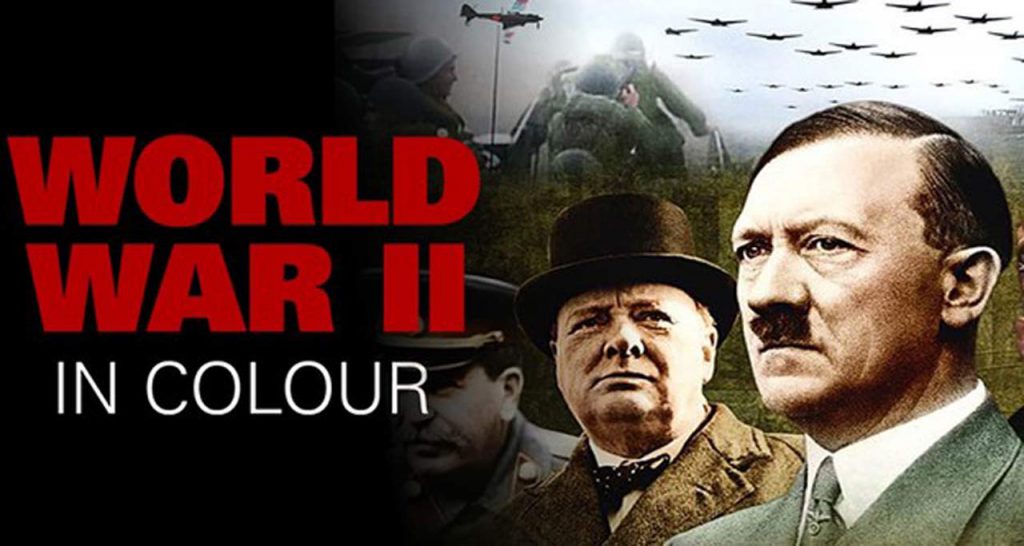World War II In HD Colour episode 10: In 1944 America and Britain in the West and Russia in the East began to close their pincer around Germany. But even now, the outcome was in the balance. The film explores the Allied disaster at Arnhem and the tragedy of the Warsaw uprising, when Polish freedom fighters were abandoned to their fate by Stalin. It tells the shocking story of the Liberation of the death camps, when the full extent of the Holocaust became clear for the first time. The film ends with Hitler’s last great gamble, as he threw all his last reserves against the oncoming Allied forces in the Ardennes.
This film tells the extraordinary story of the war in North Africa and features the heroics of the tiny island of Malta as it withstood wave after wave of Nazi assault. It ends with the Allies fighting their way up Italy and Germany in retreat. World War II in Colour is a 13-episode British television docuseries recounting the major events of World War II narrated by Robert Powell. It was first broadcast in 2008–2009. The series is in full colour, combining both original and colourized footage. The show covers the Western Front, Eastern Front, North African Campaign and the Pacific War. It was on syndication in the United States on the Military Channel.
World War II In HD Colour episode 10
Operation Market Garden
The Battle of Arnhem, also known as Operation Market Garden, was an attempt by the Allied forces to secure a bridge over the Rhine River in September 1944 during World War II. Despite the careful planning and initial successes, the operation ultimately ended in disaster for the Allies. The operation involved a combined effort of British, American, and Polish paratroopers who were dropped behind enemy lines to secure key bridges and allow the Allied ground forces to cross the Rhine and advance into Germany. The plan was to capture the bridges at Eindhoven, Nijmegen, and Arnhem, with the latter being the most important and heavily defended.
Despite initial successes, the Allies soon encountered unexpected resistance from the German forces, who were able to reinforce the area much quicker than expected. The Allies were also faced with logistical challenges, such as the destruction of their communication lines and the limited supply of ammunition and supplies. These setbacks made it difficult for the Allies to maintain their foothold on the bridge and eventually forced them to retreat. The Battle of Arnhem resulted in significant losses for the Allies, with thousands of soldiers killed or captured, and the operation was ultimately considered a failure. The failure of Operation Market Garden had a significant impact on the outcome of the war, as it prevented the Allies from crossing the Rhine and achieving a decisive victory in the Western Front.
The Battle of Arnhem also demonstrated the importance of intelligence and the need for careful planning in military operations. The Allies underestimated the strength of the German forces and failed to anticipate the challenges they would face in the field. This led to a lack of preparedness and ultimately contributed to the failure of the operation.
Despite the careful planning and initial successes, the operation ultimately resulted in disaster for the Allies and had a lasting impact on the outcome of the war. The Battle of Arnhem serves as a reminder of the importance of intelligence and careful planning in military operations and the sacrifices made by the Allied forces in the pursuit of victory.
The Warsaw Uprising
The Warsaw Uprising was a significant event in World War II and a pivotal moment in the history of Poland. It was a rebellion against the German occupation of Warsaw, led by the Polish resistance movement, that took place in August and September of 1944. Despite being vastly outnumbered and outgunned, the Polish resistance fighters fought bravely for 63 days in an attempt to liberate their city. The uprising was a response to the Soviet advance towards the city, which was expected to result in the liberation of Warsaw from the Germans. However, the Soviet forces stopped short of the city and waited for the Germans to crush the rebellion, which resulted in a brutal and bloody battle for control of the city.
The Polish resistance fighters, who were mostly poorly equipped and untrained civilians, fought bravely against the German forces and managed to gain control of several areas of the city. However, their efforts were met with a fierce and relentless response from the Germans, who used heavy artillery and bombed the city indiscriminately. Despite their bravery and determination, the Polish resistance fighters were eventually overwhelmed by the German forces and were forced to retreat. The uprising resulted in the deaths of thousands of Polish civilians and resistance fighters, as well as the near-total destruction of the city of Warsaw.
The Warsaw Uprising was a significant event in the history of Poland and had a lasting impact on the country and its people. It serves as a symbol of resistance and bravery, and is remembered as a testament to the courage and determination of the Polish people. Despite being vastly outnumbered and outgunned, the Polish resistance fighters fought bravely for 63 days in an attempt to liberate their city. Despite the outcome, the Warsaw Uprising serves as a reminder of the courage and determination of the Polish people and the sacrifices they made in the pursuit of freedom.




